The LOTR follows a mainly outdoor story line. It goes through many landscapes, from the snow and mountains of the Misties, to the great river Anduin, to the forests of Lorien. All these scenes needed to show the raw ruggedness and wilderness that is Middle-Earth. In this week's column I will discuss New Zealand, the site of the film, and some aspects of set construction.
To make a LOTR movie true to Tolkien there needs to be a background full of texture and detail. The driving principle behind the film-makers has been a desire to achieve authenticity: 'It has been remarkable,' says Peter Jackson, 'that if you want to know more about any aspect of the story of LOTR, you simply scrape away from the surface and you'll find more information, going back thousands of years. Tolkien created all that historical material and whilst it is difficult for us to put that into a movie, it is vital that the film is seen as being more than just characters in costumes walking around in a New Zealand landscape. On the practical side there has been a vast amount of unsung creativity.
| 'There is not a buckle,' says Richard Taylor of the special effects group WETA, 'that isn't branded with the coat of arms of a particular army. Every rivet head is detailed in some way. Every belt is hand tooled to feel like it has been touched by the craftsmen of the species that wears it. And, hope fully, by doing this, the audience will gain a richer, more fulfilled, perspective of the cultures that have gone on for thousands of years.' | 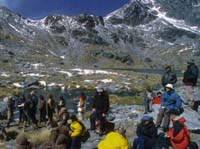 |
The sense of wonder and discovery, of vast distances and long journeys is central to the book and to the films. For the director, Peter Jackson, the landscapes depicted in the trilogy needed to fit with Tolkien's vision of middle-earth. 'The Lord of the Rings is not a fantasy per se,' he explains, 'Tolkien wrote the book as a mythic pre-history of a Europe existing in a dark age, long since forgotten. So I wanted to set the film in a slightly surreal version of a European landscape - which is exactly what New Zealand offers.' Ian McKellen, who plays Gandalf, says 'Everything here is more magnificent.
| The landscape is familiar in the sense that it's been formed by rain - just as Tolkien's Oxfordshire was - but the vegetation is unusual and the mountains seem so much sharper. If you're looking for what the poets call "the awful" - a sense of awe - then that is what you find in New Zealand. And it's wild in a way that England isn't.' Other cast members had similar things to say about New Zealand. | 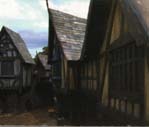 |
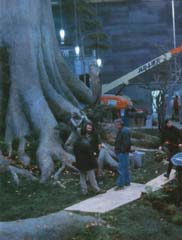 |
'New Zealand is the ideal place to shoot these films,' notes Cate Blanchett (Galadriel), 'the land mass is so young, so savage, so untamed and unruly.' Elijah Wood (Frodo) agrees saying 'New Zealand is gorgeous! I don't think that there's anywhere else we could had filmed this movie unless we had travelled to lots of different places around the world. Every element of Middle-earth is contained in New Zealand. It is perfect. There are so many different geographical landscapes: mountains, woods, marshes, desert areas, rolling hills - and the sea. Everything, in fact, described in LOTR.' In the end the film crew filmed at more than seventy locations, not counting studios, during the making of the trilogy. From rural farmland to sweeping rivers and snow-capped peaks. |
New Zealand offered an unspoiled environment with landscapes relatively uncluttered with the impedimenta of human civilization: no power pylons straddling the hills (which may explain why Auckland, a city of 3 million went without power for 2 weeks a couple of years ago.. hehe!), no motorways ripping great tears of tarmac across farmland.
| As Conceptual Artist John Howe observes, New Zealand has fewer indications of ancient human presence that are so familiar with in the European landscapes: 'Here there were no castles, no ruins, nothing to be taken into account; just this ancient ecosystem with its slightly odd-shaped rocks and trees. Whatever places were needed - age-old building, the remnants of lost civilizations- they had to be created from scratch and that gave us wonderful freedom.' | 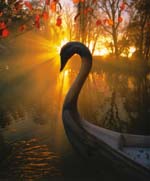 |
From personal experience I can whole heartedly agree with all the film-makers say. I have visited New Zealand 3 times (1982, 1993 and 1994), and the environment is striking. The snow capped peaks in the distance is contrasted with lush forest and raging rivers. It is a truly beautiful place. I would recommend it as a holiday destination to all!
Preparations for building Rivendell began eighteen months before the start of filming, with the planting of trees and vines that would be incorporated into a landscape that includes wooded glades and artificially-constructed waterfalls. While with the shire, a large empty sheep field is transformed in to Hobbiton. The existing lake is extended, rolling hills were enhanced by the moving of 5000 kilolitres of soil, fields were ploughed and 500m of hedges were added to the 10 acre Hobbiton site. Real flowers and vegetables were planted in the the gardens of the hobbit-holes over 12 months prior to filming. One tree that was planted was the massive oak which stands above Bag End. Winched into place and secured with steel cables and concrete, its outstretched branches were then clothed in 250000 hand painted leaves and artificial acorns.
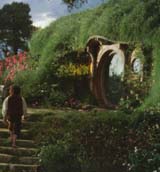 |
Bag End, with its traditional hobbit-style round doors and windows, was constructed in polystyrene artfully painted to look as if built from stone and wood. A year's exposure to the elements, combined with some authentic looking 'repairs', would eventually give the village the appearance of having been established generations ago. In fact, there were two Bag Ends: one built for those scenes in which only hobbits are featured, and another, meticulously scaled down, for shots of Gandalf and the hobbits, or to be precise, the hobbit's "scale doubles". |
Did you know....
- The song Lament for Gandalf, from the Lothlorien track on the soundtrack CD, has verses in Sindarin and Quenyan. Other tracks appearing the in movie have Khuzdul, Morbeth and Adunaic in them. Time to get my % in Adunaic up!
- The TV series Hercules and Xena both use the New Zealand wilderness as the background landscape.
- The length of the journey of Frodo from the time he leaves the shire to when he reaches Mt Doom is 6 months and 2 days.
- New Zealand actor Marton Csokas, who plays Celeborn went straight from shooting LOTR to a part in Star Wars Episode II. Not a bad rise to fame for a little known actor!
- Pictured on the table in Bag End during a conversation between Gandalf and Frodo is some cake like creations with some honey next to them. Could this be bannocks???